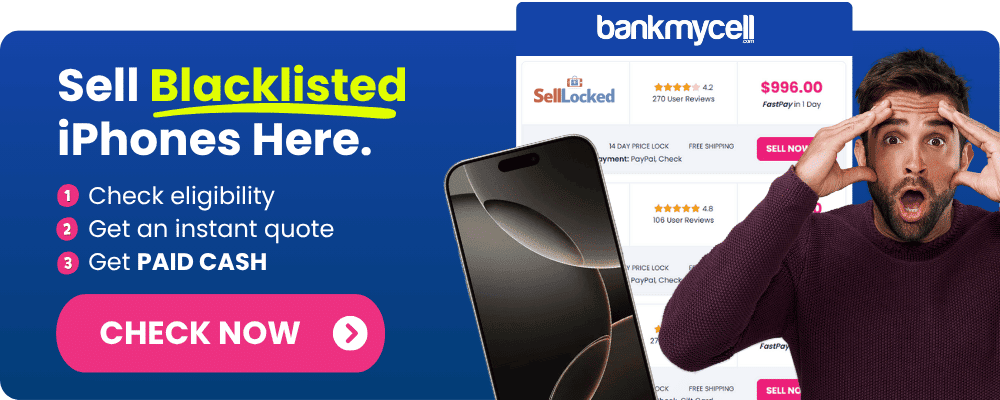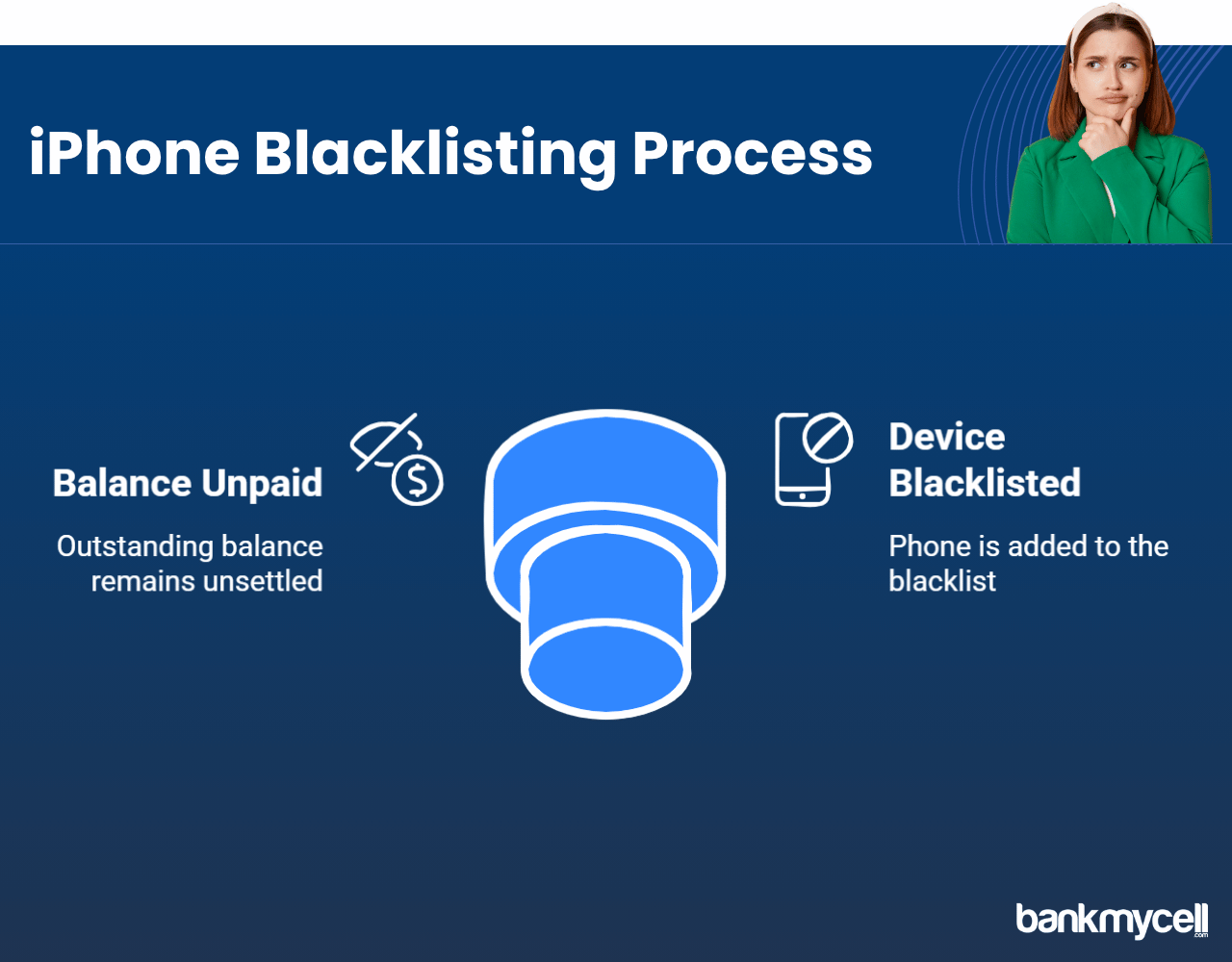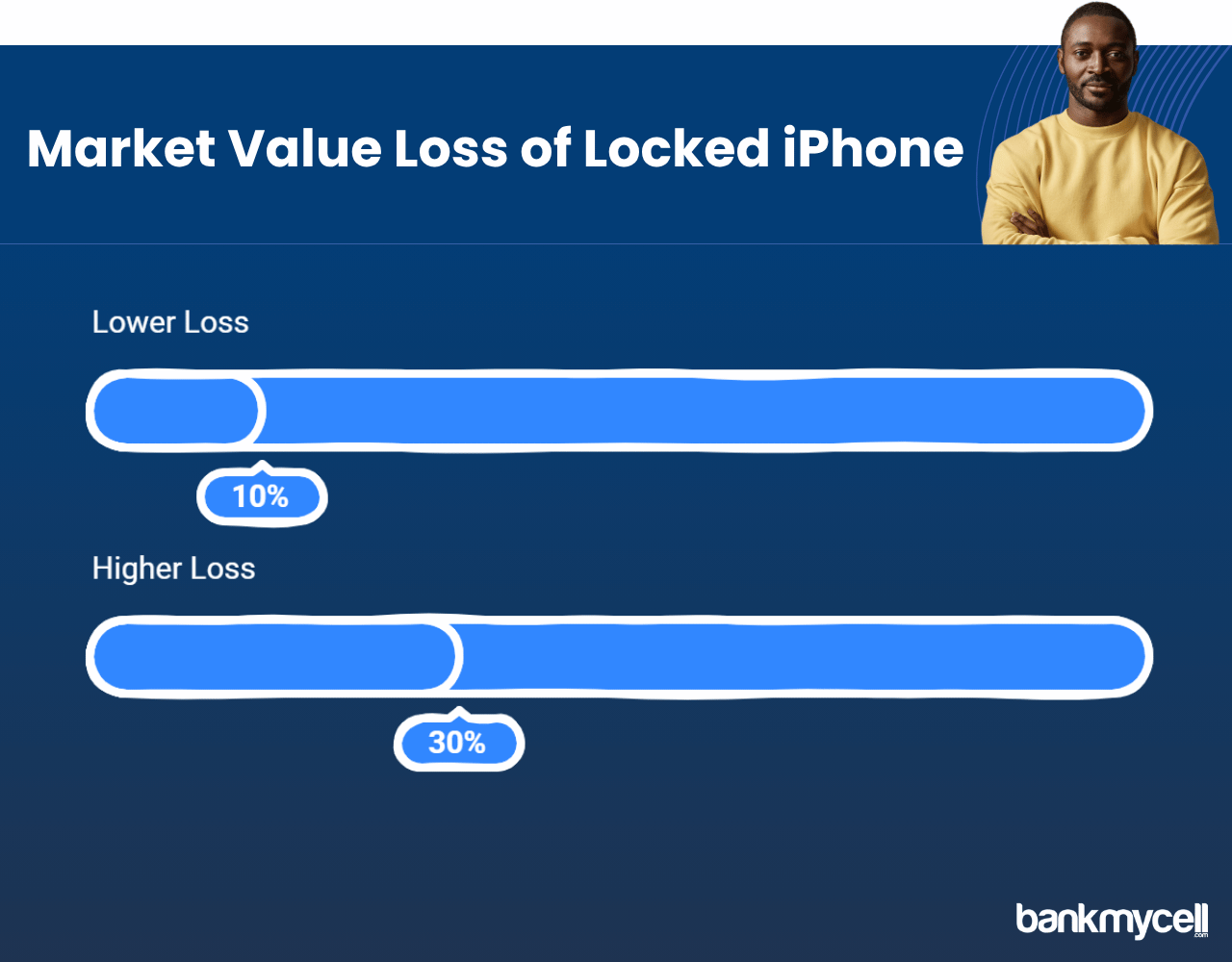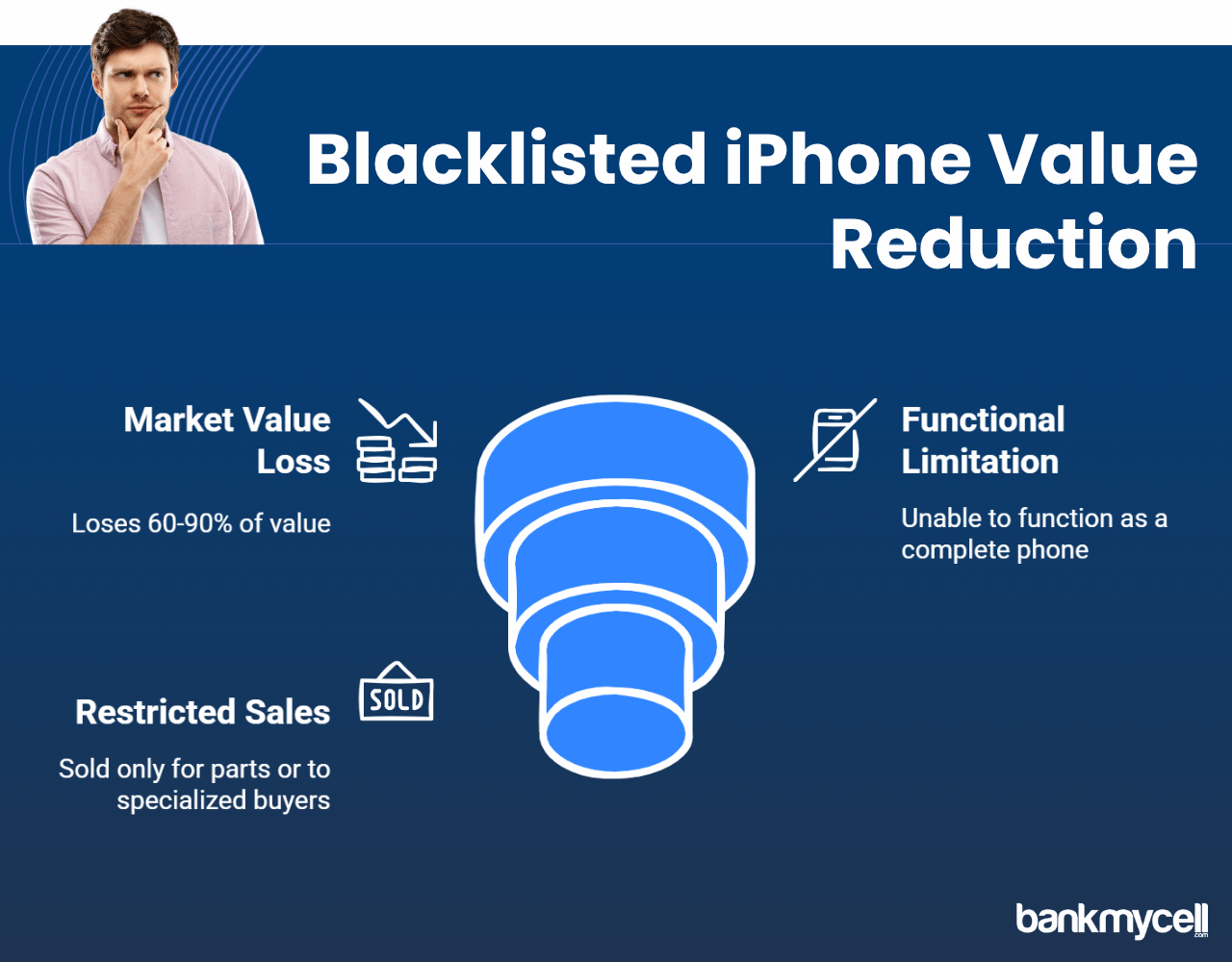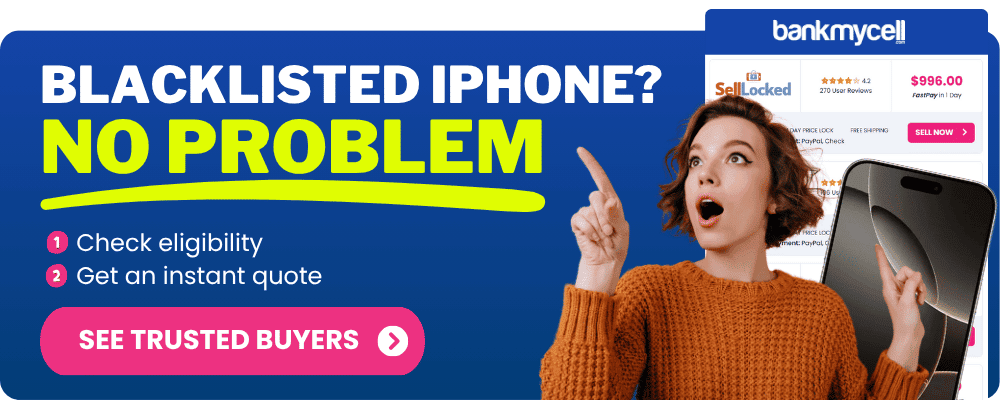What is the Difference Between Locked and Blacklisted iPhone: Understanding the Restrictions
60-Second Summary
Locked iPhone: Fully functional but locked to a specific carrier—can be used to make calls, send texts and use data with the original carrier only. Learn how to check if an iPhone is carrier locked.
Blacklisted iPhone: Unable to connect to any cellular network as it was reported stolen/lost or user has outstanding unpaid balance. Works as a Wi-Fi device only. Learn how to check if an iPhone is blacklisted.
Differences in iPhone Functionality (Summary)
iPhone Carrier-Locked Phone
- Can be used as normal with original carrier (AT&T, Verizon, T-Mobile, Sprint, etc. )
- Other carriers’ SIM cards will not work
- All features work (calls, texts, apps, camera, etc.) with that carrier
- Apple ID functionality not affected
- Interested in selling and switching carriers? Check out BankMyCell’s options for trading your iPhone in.
⛔ Blacklisted iPhone
- No cellular connectivity where blacklist is enforced (basically all countries)
- Operates as an iPod Touch with Wi-Fi only (requires purchase of separate data plan if used this way)
- All other features work (calls, texts, apps, camera, etc.) with Wi-Fi
- IMEI number is blacklisted by participating carriers globally
Potential Solutions/Differences in Resolution Expectations (Reality Check)
Locked iPhones
- Contact original carrier to unlock once eligibility is met
- Use reputable third-party service (simUnlock, DoctorSIM, UnlockBase, etc. )
- Wait for contract period to expire
- Only carrier or reporting party can remove device from blacklist
- Resolution of original issue required (pay bill, report lost/stolen, etc. )
- No reputable third-party unlocking service
- Most methods do not work — proceed at your own risk
Differences in Resale Value/Affected Market (Analysis)
- Locked iPhones: Market value drops 10-30%, may still be sold to users of original carrier
- Blacklisted iPhones: Market value drops 60-90%, usually only sell for parts or to private buyer
Differences in Detection Methodology/Pre-Purchase Steps (Verification)
- Carrier lock: Test with other carrier’s SIM card—locked phones display error like “SIM Not Valid”
- Blacklist: Enter IMEI code (*#06#) into free online blacklist checkers
- Contact original carrier: Have the carrier check status with IMEI number
Bottom Line: Carrier locks are artificial business constraints that are generally surmountable—blacklists are security features intended to be permanent. Always check both before buying a used iPhone, and be wary of any used deals that are too good to be true as they are often blacklisted devices.
Tired of dealing with a carrier-locked or blacklisted iPhone that is more headache than it’s worth? BankMyCell offers an opportunity to sell locked and certain blacklisted iPhones in any condition and make sure that your transaction is safe and secure. Discover competitive offers from legit shops that provide you with free shipping services and allow you to convert your carrier locked or blacklisted iPhone into cash toward an unrestricted replacement iPhone instead of getting tied up with confusing unlocking options or permanent restrictions.
| TODAY'S BEST LOCKED VS BLACKLISTED iPHONE RESALE VALUES | ||||
|---|---|---|---|---|
| Device | Blacklisted | Activation Locked | ||
| iPhone 16e | $360.00 | Compare | ||
| iPhone 16 Pro Max | $1045.00 | $180.00 | Compare | |
| iPhone 16 Pro | $870.00 | $90.00 | Compare | |
| iPhone 16 Plus | $420.00 | $80.00 | Compare | |
| iPhone 16 | $395.00 | $30.00 | Compare | |
| iPhone 15 Pro Max | $730.00 | $145.00 | Compare | |
| iPhone 15 Pro | $650.00 | $90.00 | Compare | |
| iPhone 15 Plus | $335.00 | $45.00 | Compare | |
| iPhone 15 | $345.00 | $40.00 | Compare | |
| iPhone 14 Pro Max | $570.00 | $70.00 | Compare | |
| iPhone 14 Pro | $400.00 | $40.00 | Compare | |
| iPhone 14 Plus | $265.00 | $25.00 | Compare | |
| iPhone 14 | $235.00 | $25.00 | Compare | |
| iPhone 13 Pro Max | $280.00 | $25.00 | Compare | |
| iPhone 13 Pro | $220.00 | $30.00 | Compare | |
| iPhone 13 Mini | $115.00 | $5.00 | Compare | |
| iPhone 13 | $140.00 | $5.00 | Compare | |
| iPhone 12 Pro Max | $150.00 | $30.00 | Compare | |
| iPhone 12 Pro | $140.00 | $10.00 | Compare | |
| * Best market prices updated December 26th 2025 | ||||

Data Source: BankMyCell compares over 100,000+ quotes and customer reviews from 20+ trusted buyback stores every 15 minutes via our data feeds, making us America’s #1 time-saving trade-in supermarket.
Disclaimer: You can sell blacklisted iPhones as long as you’re the legal owner. For example, if you bought the iPhone from a store or a person and it’s not found or stolen, you can sell it. If you’re unsure, check with the store you choose, and they will guide you.
You’re unsure about the various restrictions that apply to iPhones? You’re not alone.
During searches for pre-owned iPhones listings you will come across terms such as “locked” and “blacklisted.” Carrier locked iPhones and blacklisted iPhones both impose restrictions but stem from separate problems which lead to drastically different outcomes.
Here’s the problem:
A common mistake leads people to identify carrier-locked iPhones as blacklisted phones or misinterpret blacklisted phones as carrier-locked ones which results in unforeseen problems post-purchase.
And that’s not all…
The limitations imposed on blacklisted devices create significant variations in both their operational capabilities and value and their potential resolution.
What is a Carrier-Locked iPhone?
A carrier-locked iPhone functions exclusively with SIM cards from designated mobile carriers like AT&T, Verizon, T-Mobile or Sprint.
Carrier locking prevents the iPhone from recognizing SIM cards from any network other than the one it’s locked to.
- Switching to another carrier’s service remains impossible.
- Local SIM cards do not work on carrier-locked iPhones during international travel.
- You cannot access any competing phone carrier plans when using a carrier-locked iPhone.
Think about it:
Carrier locks are primarily a business strategy. Phone carriers use subsidies or payment plans to sell devices before locking them to make sure customers stick to their contracts.
This means:
- The phone is completely legitimate and legal
- Every aspect of the phone functions properly including calls, texts, apps and camera.
- The device works with any SIM card that is compatible with the phone’s carrier lock.
- Your mobile device operates normally as the restriction is implemented through software rather than hardware limitations.
What is a Blacklisted iPhone?
An iPhone becomes blacklisted when it gets reported as lost or stolen or when it has unpaid bills or outstanding payments on a contract or installment plan.
The IMEI number of a blacklisted iPhone gets added to a shared database accessible to all major carriers.
This means:
- A blacklisted phone loses its ability to connect with cellular networks in countries participating in the blacklist database.
- The blacklist status impacts the device across multiple regions rather than remaining limited to a single service provider.
- The physical parts of the phone function perfectly despite its blacklisted status.
The blacklisting process occurs at the carrier level when certain conditions are met.
- Someone reports their iPhone stolen or lost
- The device becomes blacklisted when the owner ceases to make their payment obligations.
- The acquisition of the device shows evidence of fraudulent activity
To check the blacklist status of your device you can use BankMyCell‘s comparison tool to find the best price for your iPhone regardless of its status. Discover the highest possible selling price for your iPhone through BankMyCell which evaluates all iPhone conditions.
Disclaimer: You can sell blacklisted iPhones as long as you’re the legal owner. For example, if you bought the iPhone from a store or a person and it’s not found or stolen, you can sell it. If you’re unsure, check with the store you choose, and they will guide you.
Key Differences Between Locked and Blacklisted iPhones
To properly manage buying and selling transactions or using a secondhand iPhone you must understand these differences.
1. Functionality Limitations of Locked vs Blacklisted iPhone
Locked iPhone:
- You can make calls send texts and access mobile data when using the original carrier.
- The phone works without issues when paired with the carrier that it is locked to.
- The camera, apps, Wi-Fi and Bluetooth capabilities continue to function normally.
- Apple ID features remain fully functional
Blacklisted iPhone:
- The device provides no cellular connectivity when used in countries that enforce blacklists.
- Can only use Wi-Fi for internet connectivity
- The device functions like an iPod Touch because apps and camera features along with Wi-Fi connectivity remain operational.
- The carrier databases include the device’s IMEI number on their blacklist
2. Cause of Restriction
Carrier Locked iPhone:
Carriers develop locked iPhones as a component of their sales approach.
The locking of a phone by a carrier usually happens when customers buy their phones through installment payment plans.
Mobile industry standards require wireless carriers to maintain device lock systems.
Blacklisted Phone:
- Reporting a stolen phone or lost iPhone leads to the device being blacklisted.
- The device becomes blacklisted when the outstanding balance remains unpaid.
- The measure serves as protection against theft and fraudulent activities concerning device security.
3. Removal Options
Locked iPhone:
- The original carrier can unlock the phone after customer eligibility requirements have been fulfilled.
- Third-party services specialize in removing locks from carrier phones.
- In most nations unlocking phones is legal which facilitates the creation of unlocked iPhones.
Blacklisted iPhone:
- The only parties who can remove a blacklist designation from an iPhone are the original owner or the carrier that placed the blacklist.
- The original owner or carrier must resolve the blacklisting issue either by paying off any remaining balance or by reporting the phone as found.
- No reputable services exist that can remove blacklists from iPhones.
- Attempts to unlock blacklisted iPhones usually fail
You need to determine if the iPhone you want to buy second-hand is carrier-locked or blacklisted before making a purchase.
Buyers of used iPhones must review both carrier lock status and blacklist status before finalizing their purchase.
Checking if an iPhone is Carrier-Locked:
Place a SIM card from another carrier into the iPhone
A locked phone will display either “SIM Not Valid” or “SIM Not Supported” when using a different carrier’s SIM card.
To determine carrier lock status look under Settings > General > About where some iPhones display carrier information.
Reach out to the phone carrier and provide them with the IMEI number.
Checking if an iPhone is Blacklisted:
- You can retrieve the IMEI number by entering *#06# on the phone or by navigating to Settings > General > About.
- Verify your phone’s blacklist status by entering the IMEI number into an online IMEI checker tool
- Contact the carrier with the IMEI number
- Comprehensive IMEI verification results are available through paid services.
Concerned about buying a used phone? The service BankMyCell works with verified buyback stores to ensure devices are properly checked before resale.
Impact on Value and Selling Options
An iPhone’s market value decreases when it faces restrictions but the extent of this impact differs based on the type of restriction.
Locked iPhone:
- Typically loses 10-30% of its market value
- Users who are customers of that specific carrier can still purchase the locked iPhone.
- Many trade-in programs and buyers will accept locked phones.
Blacklisted iPhone:
- Loses 60-90% of its market value
- Blacklisted iPhones are unable to function as complete phones and can only be sold for parts or to certain buyers who might remove the blacklist.
- Selling blacklisted iPhones is restricted to parts-only transactions or to specialized buyers who might attempt to remove the blacklist status.
Disclaimer: You can sell blacklisted iPhones as long as you’re the legal owner. For example, if you bought the iPhone from a store or a person and it’s not found or stolen, you can sell it. If you’re unsure, check with the store you choose, and they will guide you.
Helpful FAQ's
Can a carrier-locked iPhone become blacklisted?
A carrier-locked iPhone can end up on a blacklist when someone reports it as lost or stolen or when the original owner fails to continue their payment obligations. The restrictions imposed by a carrier lock and a blacklist status function independently from each other.
Will a factory reset remove carrier lock or blacklist status?
Factory resetting will not remove either restriction. The IMEI number recorded in carrier databases manages both carrier lock and blacklisting rather than the software of the phone. Network lock and blacklist status cannot be eliminated through a reset process.
Can I use a blacklisted iPhone in another country?
It depends. Blacklisted devices become unusable around the world because multiple nations share blacklist databases. A few countries opt out of these agreements which may authorize use of blacklisted phones within their mobile networks.
Is it legal to sell or buy a blacklisted iPhone?
Selling a blacklisted iPhone while failing to disclose its status violates ethical standards and may break the law. While purchasing such a device isn’t against the law it operates with multiple restrictions and stolen versions may be claimed back by the original owner through police intervention.
Can I trade in a carrier-locked or blacklisted iPhone?
Most iPhones locked to carriers can be traded in with higher acceptance when the trade-in happens through their associated carrier. Mainstream trade-in programs do not accept blacklisted iPhones because they cannot be used for cellular service and their status is compromised.
Wrapping It Up
Knowing the distinction between locked and blacklisted iPhones helps you navigate the used phone market effectively. Each of these conditions limits phone functionality but represent distinct problems.
- You can usually resolve the carrier restrictions that affect locked phones.
- Devices on the blacklist face serious restrictions because they have been identified as lost or stolen and these restrictions are typically severe and permanent.
By knowing these differences, you can:
- Stay well-informed to make smart purchases when acquiring a used iPhone
- If you encounter a phone restriction you need to know your possible courses of action.
- Stay vigilant to protect yourself from deceptive offers and listings in secondary market transactions.
Before purchasing any device ensure you verify its status and approach deals that look too favorable with skepticism because they usually are scams.
